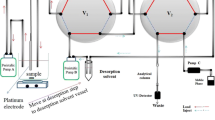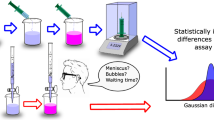Summary
An all-glass sampling cell assembly is described for the rapid, convenient micro-determination of the pH or pCl values of solutions.
The cell consists essentially of two electrode compartments (tubes) joined by a capillary tube provided with a spherical glass joint for disconnection, and plugged with asbestos fibre. One compartment contains the measuring electrode (glass, or silver-silver chloride), a hollowkey tap at the bottom for drainage, an inlet funnel for sample introduction, and an overflow tube for the drainage of surplus sample solution. The other compartment contains the calomel reference electrode with a single salt-bridge for pH measurements, or a double salt-bridge for pCl measurements.
Advantages of the cell assembly are the small sample volume necessary (0.5 ml), and the elimination of damage of the electrodes caused by handling, of the risk of sample contamination or of possible interchange when using small beakers, etc., and of chloride error in pCl-measurements. A rapid change-over from one sample to the next reduces the time necessary by classical methods to about one-third in serial determinations.
Connected to a recording potentiometer, the cell may be used (without any modification) for the continuous measurement of pH values, or pCl values in sample streams (column effluents, etc.).
Zusammenfassung
Eine vollständig aus Glas gefertigte Anordnung zur Aufnahme der Probe für eine rasche und einfache Mikrobestimmung des pH-oder pCl-Wertes von Lösungen wurde beschrieben.
Sie besteht im wesentlichen aus zwei durch eine Kapillare verbundenen Blektrodenkammern mit einem Kugelschliff, die mit Faserasbest verschlossen sind. Eine Kammer enthält die Meßelektrode (Glas bzw. Silber-Silberchlorid) und ist mit einem Hohlkückenhahn zur Spülung, einem Einfülltrichter für die Probezufuhr und einem Überlaufrohr für den Ablauf des Lösungsüberschusses versehen. Die andere Kammer enthält die Kalomel-Bezugselektrode mit einer einfachen Salzbrücke für pH-Messungen oder einer doppelten Salzbrücke für die Bestimmung des pCl.
Vorteile dieser Anordnung sind: das kleine Probevolumen (0,5 ml), die Verhinderung einer Beschädigung der Elektroden bei ihrer Handhabung, einer Verunreinigung oder Verwechslung der Probe durch die Verwendung kleiner Bechergläser u. dgl., sowie Ausschaltung des Chloridfehlers bei der pCl-Messung. Die rasche Auswechslung der Proben verkürzt die Analysenzeit bei Serienbestimmung auf etwa ein Drittel.
Mit einem Registrierpotentiometer kann die Anordnung ohne jede Abänderung für die laufende pH- bzw. pCl-Messung in strömenden Flüssigkeiten verwendet werden.
Résumé
On décrit un système de cuve à échantillon entièrement en verre, pour la détermination rapide et commode, à l'échelle micro, des valeurs du pH ou du pCl de solutions.
La cuve consiste essentiellement en deux compartiments pour électrodes (tubes), réunis par un tube capillaire muni d'un joint sphérique en verre afin de pouvoir les séparer et remplis d'amiante en fibre. Un compartiment contient l'électrode de mesure (verre ou argent-chlorure d'argent), un robinet à clé creuse sur le dessus pour l'écoulement, un tuyau d'arrivée pour l'introduction de l'échantillon et un tube de trop-plein pour l'écoulement de la solution échantillon en excès. L'autre compartiment contient l'électrode de référence au calomel avec un seul pont à sel pour les mesures de pH ou un double pont à sel pour les mesures de pCl.
Les avantages de ce système de cuve proviennent du petit volume d'échantillonnage nécessaire (0,5 ml) et de l'élimination de la détérioration des électrodes pendant leur maniement, du risque de contamination de l'échantillon ou de l'interversion possible quand on utilise des petits béchers, etc. et de l'erreur sur les chlorures dans les mesures de pCl. Un passage rapide d'un échantillon au suivant réduit le temps nécessaire pour les méthodes classiques d'environ un tiers pour les dosages en série.
Réunie à un potentiomètre enregistreur, la cuve peut être utilisée (sans aucune modification) pour la mesure continue des valeurs du pH et du pCl dans les courants échantillons (courants de sortie des colonnes, etc.).
Similar content being viewed by others
Literature
M. Stern andH. Schwachman, Analyt. Chemistry30, 1506 (1958).
J. G. Hanna andJ. Jura, Analyt. Chemistry31, 1820 (1959).
G. Matsuyama, Analyt. Chemistry32, 886 (1960).
Author information
Authors and Affiliations
Rights and permissions
About this article
Cite this article
Varsányi, D.V. Apparatus for rapid serial pH and pCl Micro determinations. Mikrochim Acta 49, 770–776 (1961). https://doi.org/10.1007/BF01217366
Received:
Issue Date:
DOI: https://doi.org/10.1007/BF01217366




